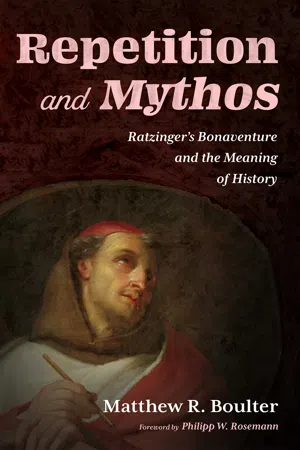![]()
1
Intimations of the Eschaton
Beginning with the End in Mind
Introduction: Ratzinger’s Rejection of Neoscholasticism, Rooted in a Concern for History
As Tracey Rowland points out in her Benedict XVI: A Guide for the Perplexed, the overarching concern which, more than any other, characterizes Ratzinger’s entire intellectual career is “the mediation of history in the realm of ontology.” This phrase of Ratzinger’s comes from his magisterial Principles of Catholic Theology, published later in the then Cardinal’s intellectual career in 1982, and hence indicates the consistency of this concern throughout his career, stretching from his early Habilitationsschrift to this point, and beyond. Moreover, in Principles Ratzinger introduces his concern for the role of history in Christian thought by calling attention to three shifts in “historical consciousness”—a concern, again, thoroughly attended to in his early work on Bonaventure—that have occurred since the events narrated in the Gospels of the New Testament. The later Ratzinger thinks that, without grasping these three epochal shifts, one cannot get clear on how and why history as such has become a pressing issue for Christian thinkers today.
The first of these is the delay of the Parousia (the immanently expected return of Christ), a dawning realization that prompted a crisis of faith among the earliest followers of Christ, the solution to which, according to Ratzinger, involved a certain embrace of Platonism. Second is the emergence of Christendom, that is, the appropriation of public power in the hands of Christian leaders in Europe, often associated with the Emperor Constantine, and his conversion to the Christian faith. In the wake of this development, the catholic mind began to shift away from an ecclesial self-consciousness of παροιχία (“sojourner”) to that of the culturally dominant steward of civilization. Third, in a shift which presages the modern mood itself, is the rupture prompted by Martin Luther, whose “appearance signaled the collapse of Christian historical consciousness.” Ratzinger does not mean here to say that Luther ushered in an epoch in which the Christian mind ceased to grapple with the meaning of history (nothing, for Ratzinger, could be further from the truth), but rather that the then-dominant manifestation of historical consciousness shifted, that the old, medieval assumptions of cultural establishment were now rejected and regarded as “anti-Christian,” however much Luther himself “remained imprisoned” within the ambit of all manner medieval assumptions about cultural power.
Of these three, the first and third in particular are prominent issues treated in the present book, since they impinge upon my argument regarding Ratzinger’s Bonaventure, and since they narrate stages along the way toward the crisis of history and historical consciousness which form the immediate context of the Habilitationsschrift’s composition, as we will see.
What, indeed, is the relationship of history to ontology, and why does it matter? To answer this question, or at least to understand Ratzinger’s sustained answer to it, one must appreciate the demise of Catholic neoscholasticism in the early to mid twentieth century, an appreciation which in turn requires a prior grasp of the urgent stress of non-Christian thinkers such as Martin Heidegger upon the constitutive power of history (and the derivative approaches of Protestant thinkers such as Rudolph Bultmann and Oscar Cullmann) as well as, finally, the relationship between history and revelation.
John Montag’s description of neoscholastism rightly stresses its ahistorical conception of revelation, propounded by the Reformation-era Jesuit Francisco Suárez. For the proponents of this view, revelation “concerns pieces of information which God has decided to disclose.” Rowland shows how these “pieces of information” or linguistic propositions are conceived as existing independently of any interpretation, in a moment unconnected to the “activation” of believing faith or even the ascent of the believer (or believing community). For reasons which (according to Rowland and Montag) have to do with the voluntaristic absolutization of the will (both divine and human), both the content and the authority of revelation are prised apart from the organic, natural—one might say “phenomenological” in the sense developed in the Introduction above, based on Plato’s image of the Divided Line—way of knowing on the part of human beings. In particular, on this neoscholastic view, no meaningful role is envisioned for sense perception, with its concomitant dynamics of Platonic eikasia and pistis as described above. There is no role, that is, for human experience, for any human experience of an event which occurs in space and time. Here, for the descendants of Suárez, the brute deliverance of the content of revelation is detached from natural knowing. So also for the believing aspect of ascent and embrace: these are held to occur mechanistically on the basis of brute, divine fiat.
One important corollary of this model of revelation is that, as objectively given and non-sensorially received, it is assumed to be opaque to human interpretation, hermetically sealed off and insulated from any need for it, as it were. From this it directly follows that, according to the adherents of neoscholasticism, revelation is immune to and exempt from any kind of historical development.
It is precisely this ahistoricity, then, which led to neoscholasticism’s demise: a growing sense of its implausibility and inadequacy in the face of a ...
